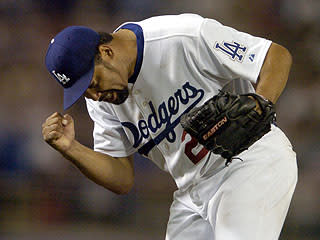Tip Drill: Five draft habits of lousy fantasy owners
Just so we're clear from the start, the world needs lousy fantasy owners. I don't actually want them to change anything about their in-draft behavior. They play a vital role in the fake-sports ecosystem, like cleaner fish traveling with sharks.
If you believe yourself to be terrible fantasy manager, then I would encourage you to read no further — just head over to the baseball sign-up page, maybe join a Pro League. This is your year, champ! Go forth and conquer. IT'S GONNA HAPPEN!
(Thumbs-up, high five, etc.)
No, not really. It's never gonna happen, fool, not unless you change your horrible draft habits.
My task today is to discuss common mistakes made by the least successful fantasy owners, people who are dead money at the draft table. But again, we need the dead money. If you're seriously determined to improve your fantasy performance in 2012, fine. Do it. Just please understand that you have an obligation to bring new low-skilled players into the game. Recruit someone to take your place among the bottom-dwellers — maybe a coworker, maybe a spouse. The pyramid scheme always needs new members. Do your part. Perhaps we'll discuss recruitment techniques in a later Tip Drill.
For now, we're focused on the five most destructive draft habits of miserable fantasy managers. Let's begin...
They enter the room with no plan at all — not even a bad plan
Over the years, I've seen many different draft strategies end in profit. There's definitely more than one path to fantasy success. I've seen winning managers build perfectly balanced rosters and wildly imbalanced rosters, going either hitting-dominant or ridiculously pitcher-heavy. For every statistical category, there are hundreds of managers who've successfully punted it. I've seen the LIMA Plan succeed, I've seen positional scarcity drafting triumph, and I've seen the best-player-available approach dominate. I've witnessed streamers and non-streamers winning head-to-head leagues. Back in the day, I won a title with six Expos on my roster, which seemed like a meaningful achievement at the time (if not a recommended strategy).
But I don't think I've ever seen a fantasy manager claim a championship in a competitive league without having some sort of plan on draft day — even if it's just a loose, not-terribly specific plan. Or even if it's a dangerous plan, fraught with risk.
If you launch the draft app without having given serious thought to roster construction, you're probably doomed. Target a few players (or stats, or roster spots, or player traits) and identify the rounds in which you'd like to get 'em. If you find yourself formulating a strategy mid-draft, it's too late. You shouldn't decide to punt a category in, say, the 12th round, because at that point you'll have likely missed any shot to benefit from the approach. The theoretical upside to punting a stat is that you plan to dominate others, and you should draft accordingly, beginning in the first round.
Fantasy owners who fail to plan for drafts often slip into familiar patterns, selecting players who've failed them before. That's no way to build a roster.
Another likely outcome of an unplanned draft is this...
When others zig, they zig, too
Position runs are almost inevitable in snake drafts. Someone will select Craig Kimbrel or Mariano Rivera or Drew Storen in Round 5, and so begins a parade of closers. If caught unaware, you can find yourself highlighting Jose Valverde's name long before you'd intended to do it. This same thing can happen with specific stats. Somebody will draft the first of the speed-only outfielders, and soon you'll be dragging Nyjer Morgan into your queue.
And this is when fantasy owners begin to overpay for mediocrity, a debilitating habit in both fake and real baseball. When every drafter in the room drifts toward a certain roster spot, you need to look for value elsewhere. The idea is to zag when others zig, to move away from the herd. If you find yourself routinely chasing position runs instead of triggering them, then there's a good chance you're never going to get value.
OK, let's veer from the errors of the ill-prepared to the mistakes of the over-prepared...
They overindulge in prospects
Prospecting is dangerous fantasy business. I'm not saying it's bad business, necessarily, but it's dangerous. For every Ryan Braun (the can't-miss player who didn't miss), there's an Andy Marte (the can't-miss kid who did). You should never expect any prospect to excel, not to the point that you're relying on their immediate success.
You need to think of prospects as decorations for your fantasy roster and nothing more. These are not foundation players — trade chips, yes. Cornerstones, no. You won't win a cutthroat league if you're too dependent on first-year guys. Don't be the owner who simply wants to show off his vast prospect knowledge on draft day, gathering as many 20 and 21-year-old talents as he can.
Bryce Harper might very well set a few records over the course of his career — maybe he'll reach or surpass every insane power projection that's already been made. And yeah, I suppose there's a possibility that he'll be with the Nationals on opening day. He's clearly earned his manager's endorsement. But let's recall that the well-hyped Harper is only 19, an age when few players visit the big leagues. If he can merely tread water with the Nats at any point in 2012, we should all be impressed. Ken Griffey Jr. was a sensation at 19, sure, but his rookie stats (61-16-61-16-.264) wouldn't have clinched many fantasy titles.
If you intend to hit the prospect market, please don't hoard. Be cautious, be thoughtful. Limit yourself to potential high-impact talents (hello, Matt Moore) and/or players who could step into significant roles (you're on the radar, Addison Reed).
The owners who stockpile prospects are often the same people making crazy reaches near the top of the draft, too. When picking in the early rounds, never give a player credit for a skill they haven't demonstrated. (We're all still waiting for the 2010 power surge, Billy Butler). You aren't going to turn a massive profit on your picks in Rounds 1-3. At that stage, you're looking to avoid staggering losses. Think floor early, ceiling late.
They overreact to spring training numbers
I won't tell you that spring stats are completely irrelevant when we're evaluating players for fantasy purposes. Michael Morse, for example, was a monster in exhibition play last year (9 HR, .364/.421/.818!) and he carried his success into the regular season. Alex Gordon had a terrific spring, too (6 HR, 4 SB, .343/.459/.729).
But you know who else dominated in February and March? Jake Fox did. And Kevin Kouzmanoff. And Travis Buck and Nick Blackburn and Brett Wallace and Chone Figgins and...
Well, OK, we can probably stop this exercise right there. Chone Figgins hit .373/.448/.490 last spring with five stolen bases, generating a certain amount of optimism (at least from this dude). Figgins then hit .214/.261/.311 in April, and it turned out to be the best month of his miserable rotten no-good plague of a year. He finished at .188/.241/.243, a fantasy punchline.
Spring numbers are merely a smallish sample, drawn from a non-competitive environment against not-quite major leaguers. There's little doubt that spring performance matters where position battles are concerned, and we clearly need to track injuries. But you can't obsess over exhibition stats when evaluating players with well-established roles and extensive MLB track records. Pitchers typically use the spring to build arm strength, to experiment, occasionally to headhunt. Matt Garza was miserable in the Cactus League last year (1-4, 10.38 ERA, 2.26), but excellent in the regular season. With vets in their prime years, you're better off ignoring the spring returns.
OK, one final bad habit of lousy managers, then we're done...
They collect category specialists
As a general rule, I hate to put myself in a position where a single player — no matter how reliable he might be historically — needs to absolutely carry my team in any given stat. If that guy breaks, you have a hopeless situation. Ideally you'll have some level of redundancy on your roster, several sources for each stat, a collection of multi-category fantasy assets. They can't all be 20/20/.300 players, but they don't have to be 0/35/.240 guys, either. (Or 37/6/.221 players. This is the year I quit Mark Reynolds).
If, at the end of your draft, you find yourself saying, "Well, if Carlos Gomez can have a breakout season..." then you're pretty much hosed. Because A) you shouldn't need Carlos to do anything, B) he probably won't do much of anything, and C) even in the best-case scenario, he's just a one-stat contributor. Those "cheap steals" guys are quiet killers when you're forced to play 'em, as they're often severe liabilities in four categories.
And so ends my list of five. You're free to keep it going in comments, or tear it apart. As long as you sign up for some fantasy baseball, we're cool.
More sports news from the Yahoo! Sports Minute:
Other popular content on Yahoo! Sports:
• More Fantasy baseball: Turmoil at the top: Who's No. 1? | Preseason top 100
• Red Sox pinch pennies after September's beer-soaked collapse
• Even Kobe bows to Jeremy Lin's star power | Jeremy Lin photos

 Yahoo Sports
Yahoo Sports 





